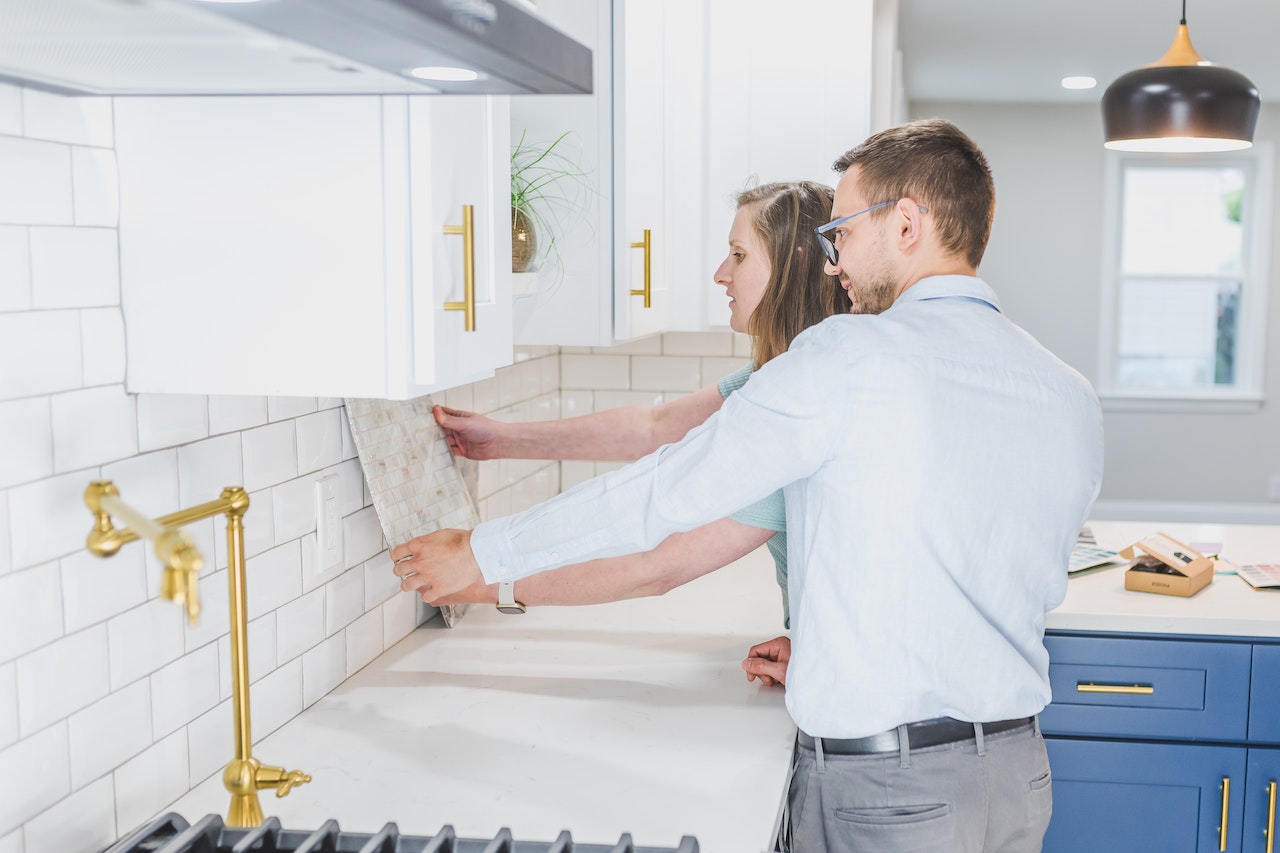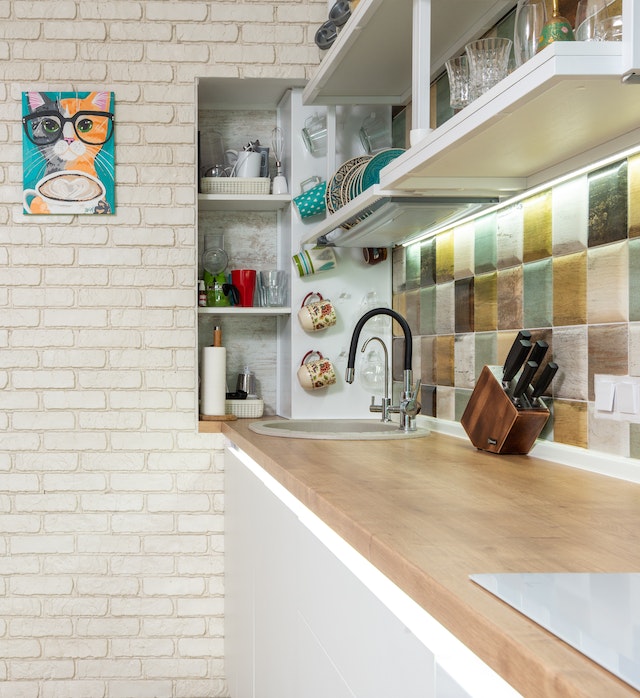Peel and Stick Tiles
Posted by Mike Belk on Jan 01, 2023

Peel-and-stick kitchen backsplash tiles are a popular choice for homeowners looking to update the look of their kitchen without a major renovation. These tiles are made with a self-adhesive backing that allows them to be easily applied to a wall surface without needing special tools or adhesives. They come in various styles and patterns, making it easy to find a design that fits your taste and kitchen décor.
Peel-and-stick kitchen backsplash tiles have become increasingly popular in recent years due to their ease of installation and relatively low cost.
Why peel-and-stick backsplash tiles are popular
Ease Of Installation:
One of the main reasons why peel-and-stick tiles are so popular is their ease of installation. Unlike traditional backsplash materials, which require mortar or thin-set, peel-and-stick tiles can be easily applied by anyone, regardless of their skill level. It makes them an excellent option for homeowners who want to do the installation themselves or for renters who want to avoid making any permanent home changes.

Budget-Friendly:
In addition to their ease of installation, peel-and-stick tiles are also generally more budget-friendly than traditional backsplash materials such as ceramic or glass tiles. They are a good option for homeowners who want to update their kitchen on a tight budget.
Flexibility:
Peel-and-stick tiles are also a great choice for homeowners who want the flexibility to change the look of their kitchen without committing to a permanent installation. These tiles can be easily removed or repositioned if needed, allowing homeowners to switch up their kitchen design as often as they like.
Why may traditional backsplash materials be a better solution?
However, while peel-and-stick tiles may be a convenient option for some homeowners, there may be better choices for a kitchen backsplash. Here are a few reasons why traditional backsplash materials may be a better solution:
1. Durability:
Traditional backsplash materials, such as ceramic or glass tiles, are generally more durable and long-lasting than peel-and-stick tiles. It is because they are secured to the wall with mortar or a thin set, which provides a stronger and more permanent bond. Peel-and-stick tiles, on the other hand, may come loose over time due to the adhesive losing its grip.
2. Heat resistance:
Some traditional backsplash materials, such as ceramic and glass, are resistant to high temperatures and can handle the heat generated by a stove or range. Peel-and-stick tiles, on the other hand, may not be able to withstand high temperatures and could become damaged if exposed to direct heat for extended periods.
3. Water resistance:
Traditional backsplash materials, such as ceramic or glass tiles, are generally more resistant to water and moisture than peel-and-stick tiles. It is essential in a kitchen, where daily spills and splashes occur. If water seeps behind a peel-and-stick tile, it could lead to mold and other damage to the wall.
4. Aesthetic appeal:
While peel-and-stick tiles may be available in various styles and patterns, they may have a different visual appeal than traditional backsplash materials. Ceramic and glass tiles, for example, can be grouted to create a more seamless and sophisticated look.
In addition to these practical considerations, a traditional backsplash may also increase the value of your home. It is because it is a more permanent and high-quality feature that can add to the overall aesthetic appeal of your kitchen.
While peel-and-stick tiles may be a convenient and budget-friendly option for some homeowners, traditional backsplash materials offer greater durability, heat resistance, water resistance, and aesthetic appeal. Considering a backsplash for your kitchen, it is worth considering all these factors to determine which option best fits your needs.

Types Of Peel And Stick Tiles:
There are several types of peel-and-stick tiles available on the market, including:
- Vinyl tiles: These tiles are made from a synthetic material that is durable, water-resistant, and easy to clean. They are available in many styles, including wood-look, stone-look, and solid colors.
- Metal tiles: These tiles are made from a variety of metals, such as aluminum, copper, and stainless steel. They can add a modern and industrial look to a kitchen backsplash.
- Glass tiles: These tiles are made from tempered glass and can add a sleek and sophisticated look to a kitchen. They are generally more expensive than other types of peel-and-stick tiles.
- Stone tiles: These tiles are made from natural stone, such as marble, granite, or travertine. They can add a luxurious and high-end look to a kitchen backsplash.
- Acrylic tiles: These tiles are made from lightweight and durable plastic. They are available in various styles and can be easily cut to fit around outlets and other fixtures.
Bottom Line:
In summary, while peel-and-stick kitchen backsplash tiles may be a convenient and budget-friendly option for some homeowners, traditional backsplash materials offer excellent durability, heat resistance, water resistance, and aesthetic appeal. It's worth considering all these factors when deciding the best backsplash solution for your kitchen.
FAQs:
(:1f539:) Does water get between the peel-and-stick tiles?
Water can get between peel-and-stick tiles if the tiles are not correctly sealed or the adhesive backing is damaged. Water can seep behind the tiles and cause damage to the wall or underlying surfaces. To prevent water from getting between peel-and-stick tiles, properly seal the tiles after installation. This can be done with a silicone sealant or a grout sealer. Sealing the tiles will help to protect the adhesive backing and prevent water from seeping behind the tiles. It is also essential to regularly inspect the tiles for any signs of damage or wear. If the adhesive backing is damaged or the tiles are coming loose, removing and replacing them as soon as possible is essential to prevent water from getting between the tiles. It is essential to properly care for and maintain peel-and-stick tiles to remain water-resistant and durable.
(:1f539:) How do you remove peel-and-stick tile without damaging it?
To remove peel-and-stick tiles without damaging them, follow these steps: 1. Heat the tiles: Use a heat gun or a hair dryer to warm the tiles and soften the adhesive backing. It will make the tiles easier to remove. 2. Use a scraper: Gently scrape the tiles away from the wall using a flat tool, such as a scraper or putty knife. Be careful not to apply too much pressure or force, as this could damage the tiles. 3. Remove any remaining adhesive: If any adhesive residue is left on the wall after the tiles have been removed, use a scraper or putty knife to scrape it off gently. You can also use a commercial adhesive remover to loosen and remove any remaining adhesive. 4. Clean the surface: Once all tiles and adhesive have been removed, clean the surface with mild detergent and water to remove any dirt or grime. Allow the surface to dry completely before applying new tiles or painting.
It is essential to be gentle and careful when removing peel-and-stick tiles to avoid damaging them. If the tiles are damaged or torn, they may not be reusable.
(:1f539:) How long does peel-and-stick tile last in the kitchen?
The lifespan of peel-and-stick tiles in a kitchen will depend on various factors, including the quality of the tiles, the level of wear and tear they are subjected to, and the proper care and maintenance they receive. In general, peel-and-stick tiles may only last for a short time as traditional backsplash materials such as ceramic or glass tiles. With proper care and maintenance, peel-and-stick tiles can last for several years in a kitchen. It is essential to regularly inspect the tiles for any signs of damage or wear and to remove and replace them as needed to prevent water from seeping behind the tiles and causing damage to the wall. It is also essential to follow the manufacturer's recommendations for the care and maintenance of the tiles. It may include regularly cleaning the tiles with mild detergent and water and avoiding exposure to high temperatures or direct heat. Overall, the lifespan of peel-and-stick tiles in a kitchen will depend on various factors, but with proper care and maintenance, they can last for several years.



